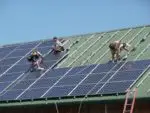
*Update: On March 15, 2025, the Canadian Federal Government announced changes to the consumer carbon tax. Effective April 1, 2025, the carbon tax will be set to $0. This means that after March 31, 2025, the carbon tax will no longer be applied to natural gas usage.
Customers will still see carbon tax charges for usage incurred up to and including March 31, 2025. For usage periods after March 31, 2025, the line-item Carbon Tax will read $0.00. Eligible Canadians will receive a final Canada Carbon Rebate payment starting April 22, 2025.
To learn more about the change to Canada’s carbon tax, click here for our detailed guide.
There have been a lot of indications that the earth is going through some climate-related changes: polar ice caps are melting; the water levels are rising, giving way to the threat of flooding in heavily populated areas, like New Orleans; weather is becoming more severe; and temperatures are increasing overall, leading to more frequent droughts, floods, and even forest fires—a problem that has a lot of resonance with Fort McMurray right now.
While there are a few natural factors for some of these changes, the most prominent cause is humans. Greenhouse gases, which are produced by burning fossil fuels like coal, natural gas, and oil, are trapping heat within our atmosphere, which means that the more greenhouse emissions, like carbon dioxide, we produce, the warmer it’s going to get. The earth has a few natural defences that could help us to combat these high levels of greenhouse gas emissions (trees, for the most part), but in order for these to begin to reverse the extent of damage we’ve already caused, we need to drastically reduce the number of greenhouse gases we are producing. Carbon pricing is designed to help us do that.
What is carbon pricing?
Alberta’s carbon levy and rebates form a way of putting a price on carbon by rewarding families, businesses, and communities for taking steps to lower their emissions. Carbon pricing also forms a means of diversifying the energy industry, boosting the economy while repairing the environment by creating new jobs and opportunities for new energy products in the market. The carbon levy describes a fee that will be included in the price of all fuels that emit greenhouse gases when combusted.
As of January 1, 2017, the carbon levy will be applied to fuels at $20/tonne, and in 2018 will increase to $30/tonne. Carbon rebates will be available to low- and middle-income homes to help offset the costs associated with the levy, and the small business tax rate will be cut by one-third to help businesses.
The carbon pricing model is predicted to cover 78-90 percent of Alberta’s emissions.
How will carbon pricing help?
Carbon pricing is intended to encourage individuals to make small changes to their lifestyles to reduce their carbon footprint. Individuals who make an effort to reduce their emissions will end up reducing their carbon levy, and thus saving money, as a result.
How can I reduce my carbon emissions?
Reducing your carbon footprint is not complicated. All it takes is a few small steps, and an effort to be more conscientious about what you are using. Turning down the heat or air conditioner when no one is home; installing smart thermostats; choosing more fuel-efficient vehicles, or choosing to walk, take public transit, or bike instead of drive; using energy-efficient appliances; and taking advantage of energy efficiency programs can all help reduce the amount of emissions you produce, and thus reduce the cost of carbon pricing.
How can I make the transition easier?
Six in 10 homes will automatically get the carbon rebate, without having to apply. However, if you are looking to make bigger changes that will help lower your carbon emissions significantly, keep an eye out for government incentives and tax breaks that will help to offset the costs of larger investments. For further ways to keep the cost of carbon pricing to a minimum, check out green energy options in your area. You might be surprised at how much more than the levy you can save by going green.











